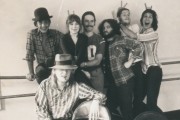 Perhaps the hardest genre to tackle in independent film is the historical biography. So when a director decides to tackle not only an independent historical biography of Abraham Lincoln’s right-hand man, but to shoot it utilizing actual Civil War-era photographs as backgrounds, it’s worth noticing even though a huge-budget film based on the 16th President is currently racking up awards and nominations.
Perhaps the hardest genre to tackle in independent film is the historical biography. So when a director decides to tackle not only an independent historical biography of Abraham Lincoln’s right-hand man, but to shoot it utilizing actual Civil War-era photographs as backgrounds, it’s worth noticing even though a huge-budget film based on the 16th President is currently racking up awards and nominations.
Saving Lincoln tells the story of Lincoln’s relationship with Ward Hill Lamon (Lee Coco), who began as Lincoln’s law partner and became Lincoln’s bodyguard during his presidency. While Lincoln might be the most beloved United States President today, during his presidency he was constantly threatened by assassination plots over his leadership. The movie opens with Lamon being questioned by Lincoln’s closest friends about where he was during Lincoln’s assassination, and the movie traces the complex relationship between the two men during one of the most trying times in our nation’s history.
It would be easy to dismiss Saving Lincoln as the “Asylum” version of Steven Spielberg‘s Lincoln (i.e. a cheaply-made knock-off meant to cash in on the interest created by a mainstream movie), but that would be inaccurate and unfair to director Salvador Litvak (When Do We Eat?), who also co-wrote the film with wife and collaborator Nina Davidovich, since the movie has a lot to offer. Saving Lincoln follows the Sin City technique of shooting most of the film on green screen and putting in the background afterwards. However, instead of creating computer generated backgrounds, Saving Lincoln uses actual photographs from the 1860s as backgrounds for the film. Not only did this obviously save the production money on sets and props, but it adds a semblance of authenticity not seen in any film ever before. It’s likely that if this movie were made before green screen became financially viable (as it has in recent years), Saving Lincoln would have been filmed on small, dimly-lit cheap sets.
However, I’m not entirely sure if that wouldn’t have been a better choice since the backgrounds of vintage photographs are sometimes awkwardly static — especially when there are people posing in those background images, and I can’t imagine the effect being any better if it were broadcast on a high definition televisio ns. It ends up being one of those effects you admire more in principle than in practice. But unlike most reviewers of The Hobbit I’m not going to focus my whole review on the technological issues of the film.
ns. It ends up being one of those effects you admire more in principle than in practice. But unlike most reviewers of The Hobbit I’m not going to focus my whole review on the technological issues of the film.
Though filming obviously wrapped before Spielberg’s Lincoln hit theaters, star Tom Amandes surprisingly plays a Lincoln similar to the Daniel Day-Lewis version by not falling into the common deep-voice, stiff-moving Lincoln common in earlier films. His Lincoln is both animated and affable, and he’s by far the best actor in the movie among its cast — after all, the most recognizable face is The Office‘s Creed Bratton in a serious role as Senator Charles Sumner (whom Bratton looks nothing like). On the other hand, the other lead, Lea Coco, isn’t as convincing as Lamon. He’s a fine actor — his previous credits include J. Edgar and episodes of The Client List — but he’s not seasoned enough to carry the movie, especially opposite Amandes. In fact, he seems downright nervous in the role, and although that’s certainly part of Lamon’s vigilant character Coco is overdoing it, particularly in his over-dramatic voiceover narration. Lamon could be — should be — a complex character based on his deep relationship with Lincoln, but his quintessential attribute seems to be his nervousness, and that ends of dominating his whole character throughout the film. While it’s obvious Lincoln was always in danger, it’s a bit overdone. That might be why toward the end of the film Lincoln thankfully gets more screentime than Lamon. The only other standout is Penelope Ann Miller as Mary Todd Lincoln, who doesn’t give Sally Field a run for her money but definitely does well as Lincoln’s superstitious wife.
If you could look past the sometimes awkward green screen effects, there is a lot of historical worth to Saving Lincoln. It’s an ambitious leap for Litvak, and I imagine the film’s biggest weaknesses would have been eliminated with a bigger budget. So he deserves credit for making this film knowing that it would face comparison with Spielberg’s epic, even if the attempt is more impressive than the final result.
Rating: A worthy historical story made into a movie that doesn’t fulfill its technological promise (5/10).
Saving Lincoln will open in New York City, Washington DC, Los Angeles, and Chicago on February 15.
//















Recent Comments